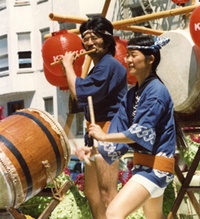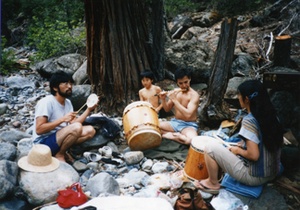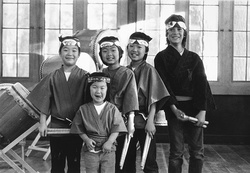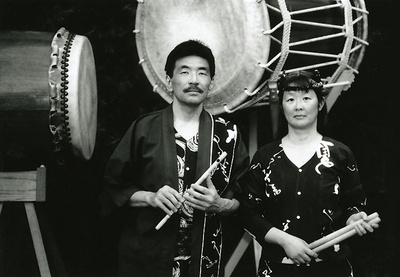“This woman came up to me and said, ‘I don’t know why, but I just burst out crying when you were playing taiko,’” Jeanne Aiko Mercer says.

Russel Baba & Jeanne Mercer playing with San Francisco Taiko Dojo, San Francisco, CA, ca. 1978. Collection of Jeannie Mercer and Russel Baba.
“That happens a lot,” the pioneering taiko artist explains. “I think taiko is very healing. It’s a release, and I think people need that in their lives.”
For Mercer and her husband Russel Baba, who founded the renowned Shasta Taiko group in 1985, the thundering rhythms of the taiko drum are more than just music—they’re an affirmation of life.
“The first time I saw a taiko performance, it just blew me away because it was so powerful and physical,” recalls Mercer, who is generally recognized as having the most years of experience among American women taiko players. “I thought it was wonderful, especially for the women, because it made them yell, shout, and really express themselves in a very powerful way.”
“Taiko has helped me gain confidence in myself and build self-esteem as a Japanese American,” says Russel Baba. “I was born right after World War II and the attitude toward anything Japanese at that time had negative connotations.”
“But teaching taiko to non-Asians has shown me that something like taiko is sorely needed everywhere,” Baba adds. “There are basic life lessons that everyone could experience by active participation in taiko or other arts or cultural activities. There is nothing like playing drums with others and playing a big taiko is a very unique and powerful experience.”
At first glance, Mt. Shasta, California, might seem an unlikely place to practice Japanese American-style cultural drumming. Located at the base of a 14,000-foot volcano in northern California, about 50 miles south of the Oregon border, the town of Mt. Shasta is known more for its outdoor recreational activities such as camping, fishing and hiking.
But Baba and Mercer see it as a very special setting uniquely well suited for creating music.

Russel Baba, Jeanne Mercer, and Masato Baba with Kenny Endo, ca. 1990. Collection of Jeannie Mercer and Russel Baba.
“Almost all of my compositions, I would say, come from the connection with nature,” says Mercer.
“The material itself that we play on is natural,” Baba notes. “I really enjoy that feeling of the drum—just of the wood and the skin. Then, living in nature, I just absorb it. I don’t know if I consciously come out with compositions that way, but I feel that it does affect me. The presence of that mountain is there. And I also think of the connections to Mt. Fuji in some ways, because my grandfather was from Yamanashi-ken, which is at the base of Mt. Fuji.”
“And in Mt. Shasta, we were fortunate enough to meet a medicine man,” says Baba. “We sweated with him and learned songs that he sang and those kind of things, which I took inside. Drumming is one way that people can find something so simple. It’s just the beat—a heartbeat and rhythm of nature.”
Baba has also used the rhythms and instruments of taiko for experimentation. A versatile musician who also plays saxophone and flute, Baba has incorporated taiko with jazz for many years. Finding a balance between the two sharply contrasting musical styles continues to be an exciting challenge for him.
“Japanese seem to always have a very formal approach to anything, especially the arts,” Baba says. “So for me, I feel like I’m between two worlds. Basically, taiko is formal. Everything is planned before—rehearsed and polished. The type of jazz I learned and love to play is more spontaneous, freer, looser.”
“I’m just beginning to feel more comfortable about being uncomfortable, realizing it is healthy and reflects where I am—as an artist and as a person—in so-called conflict,” Baba says. “Walking in two worlds—traditional/modern, East/West, form/freedom, mind/heart. And that may reflect where we all are living today.”
In addition, he expresses optimism for what music may reflect tomorrow. Baba and Mercer’s son, Masato Baba, is also an accomplished musician who has had a lifelong passion for taiko and has toured as a member of the Kenny Endo Taiko Ensemble.
“It is really a blessing to see Masato develop as an artist and into an outstanding person,” says Baba. “He is my inspiration and a teacher.”
“American taiko and the modern taiko movement is a relatively new, growing art form,” Baba observes. “Taiko is more than simply playing a drum. Playing music is more than hitting the right note or being on time. It may be more about centering and balance and maintaining tension, presence, and effort with relaxation. It is a life experience and a nurturing experience. The act of playing and participating is life.”
* This article was originally published on the Japanese American National Museum Store Online.
© 2006 Japanese American National Museum








